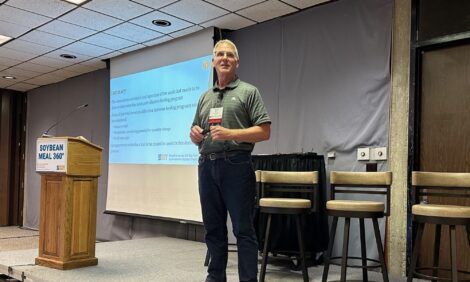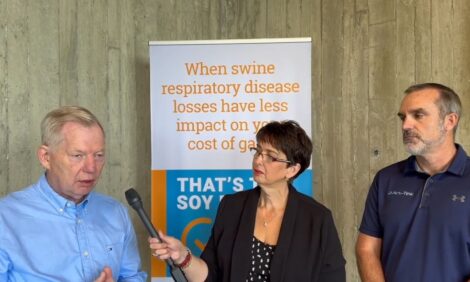



Finally, there’s a solution to the summer carcass weight dip
Strategic use of soybean meal to maximize pig carcass weight during the summer dipPart of Series:
Next Article in Series >
Editor’s note: David Rosero, PhD, assistant professor of animal science at Iowa State University, and R. Dean Boyd, PhD, consultant with Animal Nutrition Research, recently spoke at the Iowa Swine Day Pre-Conference Symposium, titled Soybean 360º: Expanding our horizons through discoveries and field-proven feeding strategies for improving pork production. The event was sponsored by Iowa State University and U.S. Soy.
Every pig producer, nutritionist and veterinarian is familiar with the summer dip. Pig weight loss hits right as market prices are typically rising in July and August, creating a double-hit financially. New nutrition studies conducted on-farm have led leading nutritionists to a solution that includes higher soybean meal inclusion rates in the summer diet.
Contributing factors to the summer carcass weight dip
- Heat stress. Caused by a rise in ambient temperatures.
- Early decline in carcass weight. Weight decline often begins before heat stress and is related to increased respiratory pathogens that occur with barn ventilation closure during cold periods, according to Paul Yeske, DVM, Swine Vet Center.
- Feed ingredients. DDGs, corn germ, corn meal and wheat middlings are especially harmful to feed intake in the late nursery and early grower up to about 130 pounds, and they still having some effect at 180 pounds. Avoid use of these ingredients ahead of and during the summer months.
According to Dr. Boyd, summer carcass weight depression depends on the producer and system, but pigs are typically lighter by about six to 12 pounds per carcass during the summer months. Pig producers face the issue routinely, not just during extreme heat conditions.
“The problem is simply a heat condition, which causes a reduction in feed intake,” he said. “Pigs experience the summer dip year after year, almost without exception, and it occurs as far north as Canada.”
One reason for the dip is corn distillers dried grains (DDGs). Once they entered the marketplace, nutritionists started using very high levels in the diet which can cause a decrease in feed intake just like the impact of heat stress.
“The economic implications of the summer dip depend on the price of the carcass, but typically the lost revenue would be on the order of $8 to $14 per carcass,” said Dr. Boyd. “July and August are the times when we typically see the greatest market price. So, the loss of revenue can be $12 to $14 per pig in the July and August time period. But the summer dip occurs from May through September 1. It's quite a long time to have low carcass weights during the only time of the year that producers make money.”
A new summer feeding strategy
Dr. Rosero, who was formerly the technical director leading the nutrition team at The Hanor Company, presented internal studies and work that he and his team conducted while at Hanor during their multi-year efforts to assemble a strategic diet for pigs that will be sold during the summer months that can eliminate the summer dip.
“When we formulate and focus on diets that decrease the feed cost but we don't go beyond the price to calculate the loss from the reduction in carcass weight, we aren’t seeing the complete financial picture,” said Dr. Rosero.
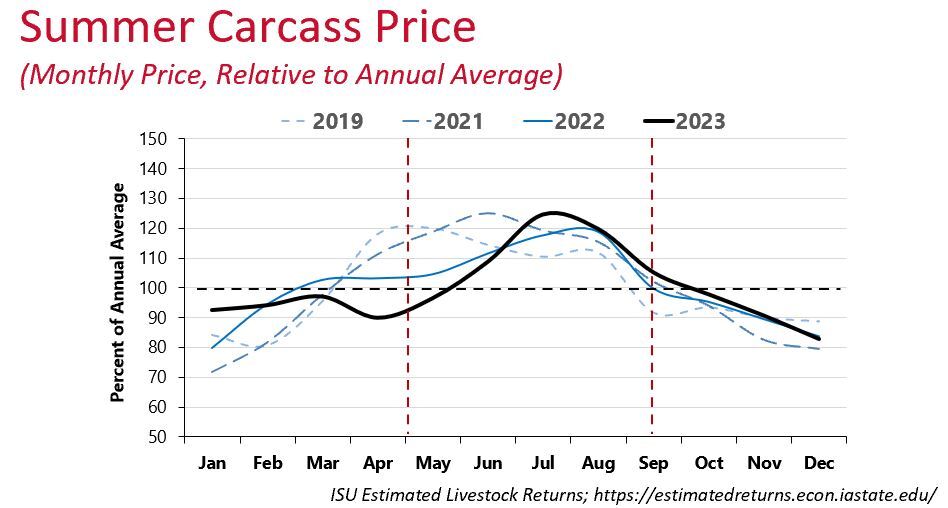
During the summer months is when the industry tends to have up to 120% of the price relative to the annual average price, creating an opportunity to capture revenue.
“At Hanor, we could see our summer carcass weights go down in our system year after year,” said Dr. Rosero. “But beyond the loss of the 6–12 pounds of weight and the lost revenue opportunity, there can be a significant increase in discounts when there is a greater proportion of lower weight pigs.”
After several years of collecting and analyzing data, Dr. Rosero and his team at Hanor developed a feeding strategy that keeps their pigs’ weights mostly steady and hitting their targets during the summer months.
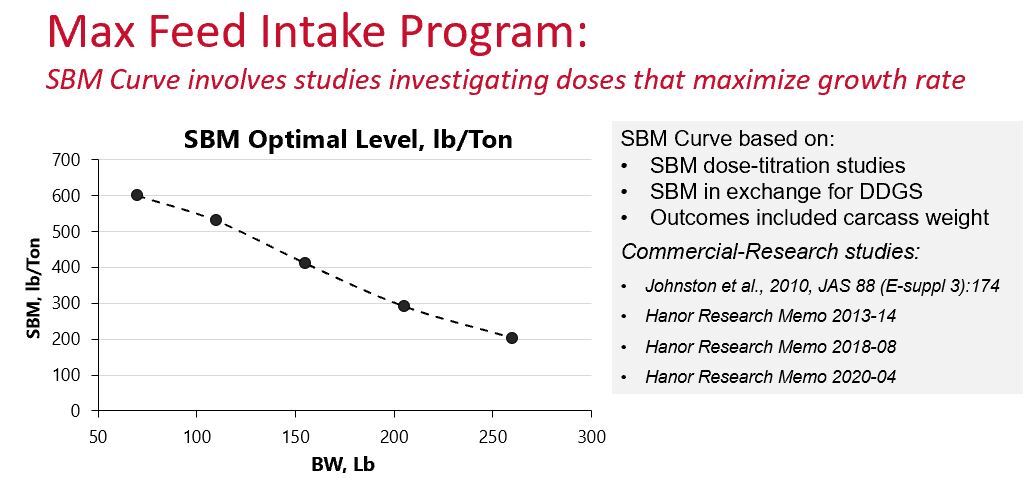
The key aspects of the Summer Soybean Meal Program to maximize feed intake included:
- No added fat (low energy). Fat prices relative to corn have been very high, so increasing the energy level of pig diets was inaccessible financially.
- Minimum soybean meal level by phase (SBM Curve). The team assembled a soybean meal minimum inclusion curve to maximize carcass performance and weight gain.
- No DDGs inclusion. This was due to the lower feed intake response and concerns over driving carcass weight down.
In a three-diet comparative modeling study, Hanor used a High Energy diet (high fat and DDGs) that was representative of previous summer diets and compared it to their Summer Soybean Meal Program . Then for a third comparison, they formulated a Low Energy diet with low soybean meal levels and DDGs to try to create a lower total cost of their diet.
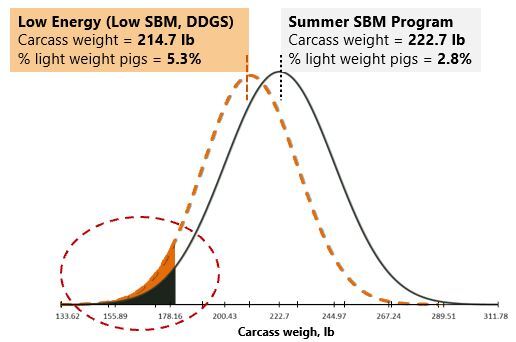
Modeling shows that by applying the Summer Soybean Meal Program, you can achieve a higher carcass weight of about 4 lbs. compared to the Low Energy diet.
“Because weight drives the percentage of pigs that will go into the plant, calculating a plant-based price that I'm getting paid for my pigs is important,” said Dr. Rosero. “This also illustrates the percentage of lightweight pigs which will affect your revenue because the plant will impose a big discount of these pigs.”
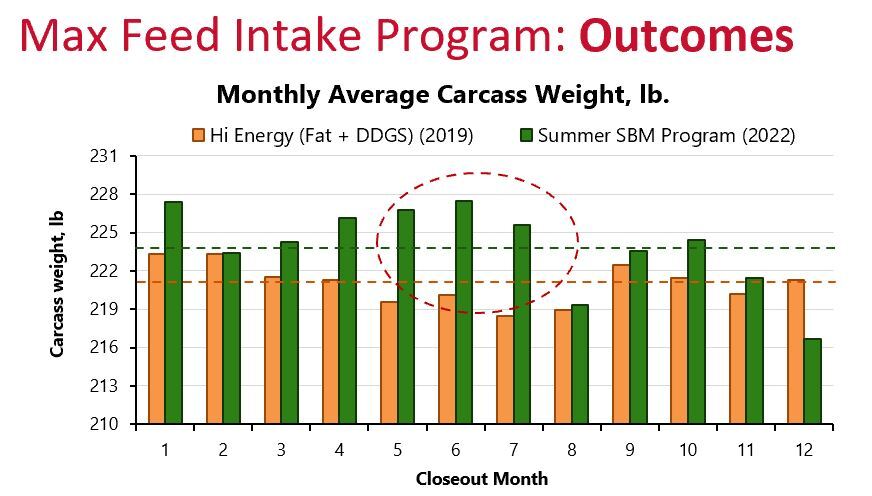
The outcomes of the program show that when applying the programs during the summer months, especially May to July, the carcass weight is higher with the Summer Soybean Meal Program. The Hanor team was able to maintain pig weight without seeing the typical summer dip.
“Looking at the revenue potential, this is a very big opportunity for producers, so don't let it go,” said Dr. Rosero. “For our systems in 2022, revenue was up by $14 per pig. The Summer Soybean Meal Program works, so I encourage producers to start working to capture this revenue.”
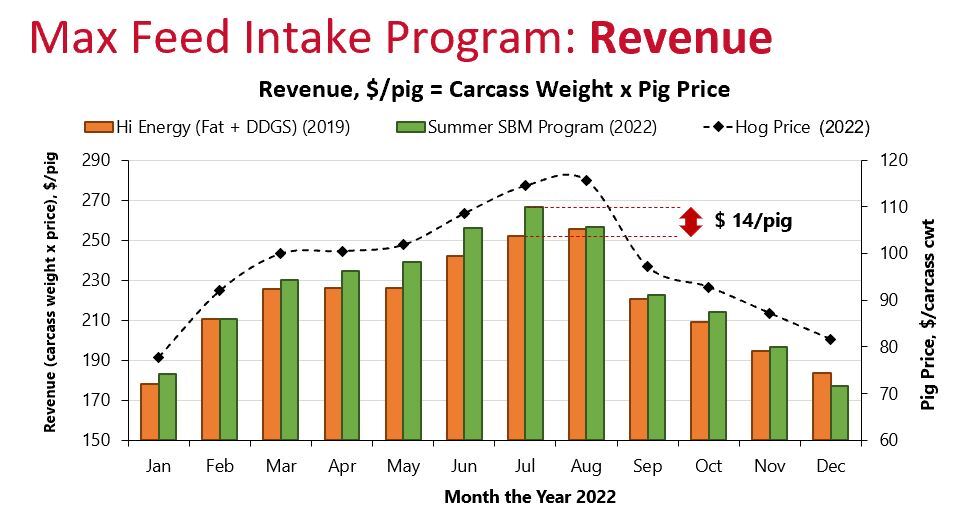
Implementing this summer feeding program through phases requires planning to ensure the timing is right. The first group of pigs will come out in late May, so their diet change needs to occur in late February.
Dr. Rosero forecast 2024 diet costs across the three diet programs they compared using projected diet costs of $2,020 per ton and a pig price of $90 per carcass CWT.
“I challenge you to take the next step. Look at the performance of the pig, calculate your feed costs per pound of gain because that's what really matters,” he said.
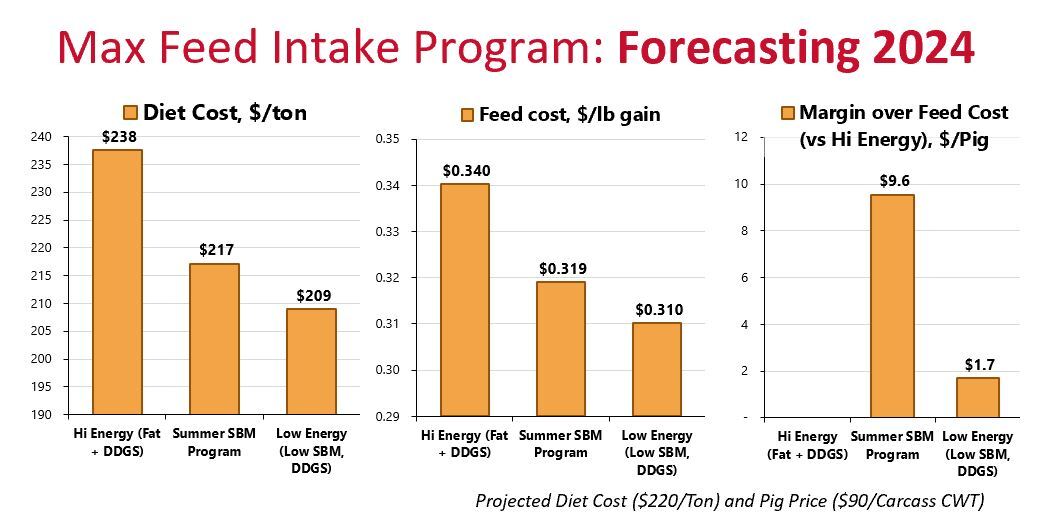
“When I apply the revenue side, my pig price, especially during summer months, at a conservative $90/carcass CWT, the best program will include a minimal level of soybean meal that maximizes the growth performance and it maximizes pig carcass weight because that is going to drive revenue and profitability into your system.”
Key takeaways
- The summer carcass weight dip is one of the greatest opportunities the industry has to increase revenue, and we have diet formations that will allow us to capture that opportunity.
- Remember that ingredients can have a negative impact on feed intake. Evaluate feed intake of your ingredients so you can understand their impact on your system and avoid intake-depressing ingredients during the summer months.
- Consider a soybean-meal-based-nutritional strategy. Look beyond the feed invoice price – maximize feed intake to maximize the growth rate of the carcass, by levels, applying higher levels to the diet and evaluating the results based on margin over feed cost.
- To implement a Summer Soybean Meal Program diet, you will need to analyze and understand what your optimal soybean meal dose is by phase to maximize the growth performance.
- Remember to start feeding the diet in February if you want to capture the value.
In the Hanor system, the summer dip had been an ongoing issue. Now, it's solved. Dr. Rosero and his team chose to tackle a serious economic challenge by doing the hard work of analyzing their data and looking at their feed ingredients differently. He encourages nutritionists and producers to take action and capture this revenue opportunity in their system.
“For our nutritionists, when your leaders are looking over your shoulder and asking why your feed costs are higher, it puts you in a tough position. Ask for their patience and set up a strategic summer diet that costs about $10 or $12 higher using soybean meal, and the summer dip will essentially disappear. And you'll become a hero,” said Dr. Boyd.
Click here to learn more.










